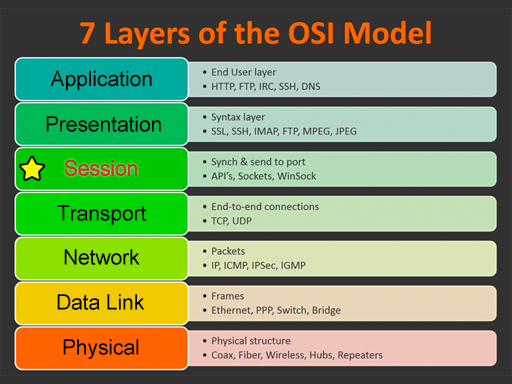|
|
| This glossary uses network terms from the OSI model. Click on one of the categories on the left or on the image below. Click the View All link to see all terms. Use the alphabet to jump to that letter. Some of the terms could be used on multiple layers, but they are grouped in the most common layer. |
Session

View All
|
|
|
#
A
B
C
D
E
F
G
H
I
J
K
L
M
N
O
P
Q
R
S
T
U
V
W
X
Y
Z
|
A
APIs |
| Stands for "Application Programming Interface." An API is a set of commands, functions, protocols, and objects that programmers can use to create software or interact with an external system. It provides developers with standard commands for performing common operations so they do not have to write the code from scratch. (Session Layer) Top |
|
|
C
Codec |
| A portmanteau of coder/decoder; an algorithm or a device using such an algorithm for converting analog sounds to digital bit streams (coding) and back (decoding). Codecs are almost as numerous in their uses as in their types. One use for codecs is in converting voice into a digital bitstream for storage or transmission across a network. (Session Layer) Top |
|
|
Cookie |
| A piece of data stored on a user’s system by their web browser. Some cookies are helpful and welcome while others are unwelcome because they invade the privacy of the user. (Session Layer) Top |
|
|
S
Sockets |
| When a computer program needs to connect to a local or wide area network such as the Internet, it uses a software component called a socket. The socket opens the network connection for the program, allowing data to be read and written over the network. It is important to note that these sockets are software, not hardware, like a wall socket. So, yes, you have a much greater chance of being shocked by a wall socket than by a networking socket. (Session Layer) Top |
|
|
W
Winsock |
| Winsock is actually short "Windows sockets," which are files that allow Windows programs to connect to the Internet and other computers. Technically, Winsock is an "Application Programming Interface (API)," that developers use to make their programs network-enabled. 16-bit applications use a file called WINSOCK.DLL and 32-bit applications use a file called WSOCK32.DLL. Both of these files are libraries of networking functions (based on TCP/IP), but they can differ from computer to computer, depending on the vendor. (Session Layer) Top |
|
|